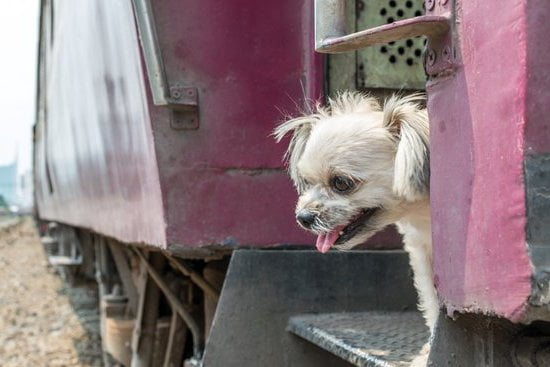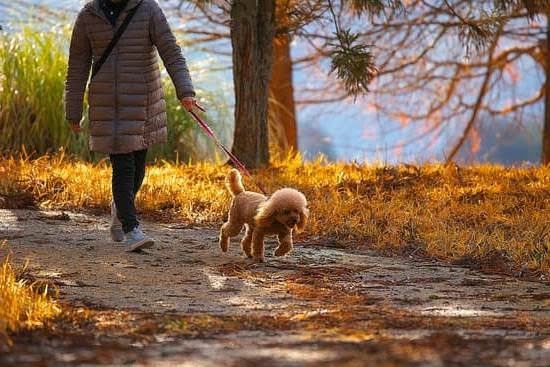How do you train dogs not to jump? This is a common question among dog owners who struggle with their pets’ jumping behavior. Dogs often jump on people out of excitement, seeking attention, or as a way to greet them.
While it may seem harmless at first, this behavior can become problematic and even dangerous if not addressed properly. In this article, we will explore the reasons behind why dogs jump, the negative impact it can have, and effective training techniques to discourage this behavior.
Understanding the root causes of why dogs jump is crucial in addressing this issue. Dogs may jump on people as a way to assert dominance, express excitement, or seek attention. By recognizing these triggers, dog owners can better tailor their training approach to effectively combat this behavior. It is important to remember that jumping is a natural instinct for dogs, but with proper training and guidance, they can learn more appropriate ways to interact with humans.
The negative impact of dogs jumping on people goes beyond just simple nuisance. It can lead to injuries, particularly for children or elderly individuals who may not be able to withstand the force of a jumping dog. Additionally, jumping can escalate into problem behaviors such as aggression if left unchecked. Training dogs not to jump is therefore crucial for their safety and the well-being of those around them.
Understanding Why Dogs Jump
Dogs jumping on people is often seen as a sign of excitement or affection, but it can become a nuisance if not addressed properly. Understanding the root causes of this behavior is crucial in effectively training dogs not to jump. One common reason why dogs jump is simply because they are seeking attention from their owners or visitors.
By jumping up, they are trying to get closer to your face to be acknowledged and petted. Another reason for jumping could be due to lack of socialization or training, leading them to display inappropriate behaviors when interacting with people.
To address the issue of dogs jumping, it is important to first identify why they are engaging in this behavior. By recognizing the motivations behind their actions, pet owners can tailor their training approach accordingly.
One effective method to deter jumping behavior is by implementing basic training techniques such as teaching the “off” command or using physical barriers like baby gates when guests arrive. Consistency in applying these methods is key in helping dogs understand that jumping is not acceptable behavior.
In addition to basic training techniques, positive reinforcement plays a crucial role in training dogs not to jump. Rewarding good behavior with treats, praise, or toys can help reinforce the desired actions while discouraging jumping. By consistently rewarding calm and polite greetings, dogs will start to associate positive outcomes with staying on the ground.
It is essential for pet owners to remain patient and persistent throughout the training process, as changing ingrained behaviors takes time and effort. Remember that consistency, positive reinforcement, and patience are essential elements in successfully training dogs not to jump on people.
The Negative Impact of Jumping
Physical Safety and Well-Being
Jumping can pose a risk to both the dog and the person being jumped on. For smaller individuals, such as children or elderly people, a jumping dog can cause accidents like tripping or knocking them over. This could result in injuries for both parties involved. Additionally, a larger dog with excessive jumping behavior could unintentionally harm someone by scratching them with their paws or hitting them forcefully.
Social Interactions
Unwanted jumping can also lead to negative social interactions for dogs and their owners. People may feel uncomfortable or intimidated by a dog who jumps on them without invitation. This behavior can be perceived as rude or aggressive, even if the dog is just excited. As a result, the owner may face challenges when bringing their dog out in public or introducing them to new guests at home.
Miscommunication and Confusion
Training dogs not to jump is crucial for effective communication between the pet and their human companions. When a dog consistently jumps on people, it may signal that they are seeking attention or trying to assert dominance. By allowing this behavior to continue unchecked, the dog may become confused about appropriate boundaries and behaviors. Establishing clear rules through training helps avoid misunderstandings and strengthens the bond between dogs and their owners.
Basic Training Techniques
Dogs jumping on people is a common issue that many pet owners face, but with the right training techniques, this behavior can be discouraged. One of the first steps in addressing this problem is understanding why dogs jump in the first place. Dogs often jump as a form of greeting or excitement, seeking attention from their owners or visitors. By recognizing this underlying motivation, pet owners can better address and correct the behavior.
There are several basic training techniques that can be used to discourage dogs from jumping. One effective method is to ignore the dog when they jump up, turning away and avoiding eye contact until they have calmed down. This helps to remove the reward of attention that reinforces the jumping behavior.
Another approach is to redirect the dog’s energy by asking them to perform a different command, such as sitting or lying down. This not only serves as a distraction but also reinforces positive behaviors.
Positive reinforcement plays a crucial role in training dogs not to jump. By rewarding your dog with treats, praise, or affection when they greet you calmly without jumping, you are encouraging good manners and reinforcing the desired behavior. Consistency is key when implementing these training techniques – ensuring that all family members and visitors follow the same guidelines will help reinforce consistency in your dog’s training regimen.
| Training Technique | Description |
|---|---|
| Ignoring Jumping | Turning away and avoiding eye contact until the dog calms down. |
| Redirecting Energy | Asking the dog to perform a different command like sitting or lying down. |
| Positive Reinforcement | Rewarding calm greetings with treats, praise, or affection. |
Positive Reinforcement
Using Treats as Rewards
One popular form of positive reinforcement is using treats as rewards for appropriate behavior. When your dog greets someone without jumping, immediately reward them with a high-value treat. Over time, they will learn that remaining calm leads to delicious rewards, making them more likely to continue this desirable behavior.
Utilizing Playtime and Praise
In addition to treats, utilizing playtime and verbal praise can also be effective forms of positive reinforcement. Whenever your dog refrains from jumping up on someone, engage in a fun game or shower them with enthusiastic words of encouragement. By associating these positive experiences with not jumping, your dog will start to make the connection between good behavior and enjoyable outcomes.
By consistently reinforcing desired behaviors through positive means such as treats, playtime, and praise, you can effectively train your dog not to jump. Remember that patience and consistency are key when implementing reward-based training methods. With dedication and the right approach, you can help your furry friend overcome their jumping habit and build a strong foundation for long-term success in their training endeavors.
Consistency Is Key
When it comes to training dogs not to jump, consistency is one of the most important factors for success. Dogs thrive on routine and predictability, so establishing a consistent training schedule is crucial. This means setting aside dedicated time each day to work on preventing jumping behavior and sticking to that schedule without fail. Whether you are using basic training techniques or positive reinforcement methods, consistency in your approach will help your dog understand what is expected of them.
One effective way to establish consistency in training is to create a set of rules and boundaries for your dog to follow. For example, if your dog tends to jump when guests arrive at the door, make it a rule that they must sit calmly before any interaction takes place.
Enforce this rule consistently every time someone enters your home, so your dog learns that jumping is not acceptable behavior. By setting clear expectations and consistently enforcing them, you can help your dog understand what is appropriate behavior in various situations.
In addition to creating rules and boundaries, consistency also involves maintaining a unified approach among all members of the household. Make sure that everyone who interacts with your dog understands the training methods being used and reinforces them consistently.
Inconsistencies in how commands are given or behaviors are addressed can confuse your dog and make it more difficult for them to learn not to jump. By working together as a team and sticking to the established routine, you can help your dog overcome their jumping habits in a coherent and effective manner.
Seeking Professional Help
Seeking help from a professional dog trainer can be incredibly beneficial when dealing with jumping issues in your canine companion. A trained expert can provide guidance and personalized strategies to address the root causes of your dog’s jumping behavior. Here are some instances where it may be time to consider consulting a dog trainer:
- If your dog’s jumping behavior is excessive and persistent, despite your best efforts to curb it at home.
- If the jumping poses a safety risk to you, visitors, or other pets in the household.
- If you have tried basic training techniques without success, or if the jumping escalates in certain situations.
Professional dog trainers have experience in assessing behavioral issues and implementing effective training methods to modify undesirable behaviors. They can work with you and your dog to create a customized training plan that targets the specific triggers causing the jumping behavior. By seeking help from a professional, you can gain valuable insights on how to train dogs not to jump effectively.
- A dog trainer can observe your dog’s behavior in different environments and provide real-time feedback on what may be contributing to the jumping.
- They can teach you proper techniques for redirecting your dog’s attention and reinforcing alternative behaviors that are more desirable.
- Additionally, they can offer ongoing support and guidance as you work towards overcoming the jumping habit together.
Remember, it is important to approach professional help with an open mind and commitment to follow through with the recommended training plan. With patience, consistency, and expert guidance, you can successfully train your dog not to jump on people.
Tips for Preventing Jumping
One of the most effective ways to prevent jumping in dogs is by providing alternative behaviors that are more appropriate and rewarding. For example, teaching your dog to sit or lie down when greeting people can redirect their energy away from jumping. By consistently reinforcing these alternative behaviors with praise and treats, you can help your dog understand what is expected of them in social interactions.
Another important strategy for preventing jumping is to avoid inadvertently reinforcing the behavior. This means not giving your dog attention or affection when they jump on you, even if it’s to push them off or scold them. Any form of interaction in response to jumping can be seen as a reward by your dog, perpetuating the behavior. Instead, ignore the jumping and only provide attention when your dog is calm and has all four paws on the ground.
Consistency in applying training techniques is crucial when working to prevent jumping in dogs. Everyone in the household should be on the same page about how to respond to jumping behavior, as mixed messages can confuse your furry friend. Additionally, consistency also involves practicing training exercises regularly and reinforcing positive behaviors consistently. With patience, persistence, and a united front from everyone involved, you can effectively train dogs not to jump on people.
| Prevention Strategies | Details |
|---|---|
| Provide alternative behaviors | Teach sit or lie down as greetings |
| Avoid reinforcement | Ignore jumping & provide attention for calm behavior |
| Consistency is key | All members practice same response & reinforce positive behavior |
Conclusion
Training dogs not to jump is a common challenge for many pet owners, but with patience and persistence, it can be overcome. By understanding the root causes of this behavior and the negative impact it can have, dog owners can implement basic training techniques and positive reinforcement to discourage jumping. Consistency in training is key, as well as seeking help from professional dog trainers when needed.
One important aspect of training dogs not to jump is to focus on prevention. This includes strategies such as ignoring the jumping behavior, turning away from the dog, or asking for an alternative behavior like sitting. By avoiding reinforcement of jumping behavior, pet owners can help their dogs learn that jumping is not acceptable.
In conclusion, training dogs not to jump requires dedication and a lot of patience. It may take time for some dogs to unlearn this habit, but with consistent training and positive reinforcement, most dogs can eventually be taught not to jump on people. Remember that seeking help from a professional dog trainer is always an option if the jumping behavior persists despite your efforts.
Frequently Asked Questions
How Do You Teach a Dog Not to Jump?
Teaching a dog not to jump requires consistent training and positive reinforcement. One effective method is to ignore the jumping behavior and reward them when they have all four paws on the ground. It’s also helpful to teach an alternative behavior, like “sit” or “stay”, that they can perform instead of jumping.
What Is the Best Command to Stop a Dog Jumping Up?
The best command to stop a dog from jumping up is “off” or “down”. These commands are simple and clear, making it easier for the dog to understand what you’re asking them to do. Consistency is key when using these commands, along with praising and rewarding your dog when they follow through.
Will My Dog Grow Out of Jumping Up?
Whether or not a dog will grow out of jumping up depends on various factors, such as their age, breed, and training. Some dogs naturally outgrow this behavior as they mature, while others may need consistent training throughout their life. By providing the right guidance and training, most dogs can learn to greet people without jumping up.

Welcome to the blog! I am a professional dog trainer and have been working with dogs for many years. In this blog, I will be discussing various topics related to dog training, including tips, tricks, and advice. I hope you find this information helpful and informative. Thanks for reading!





